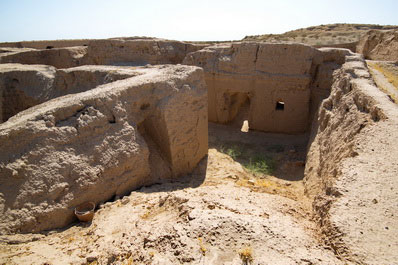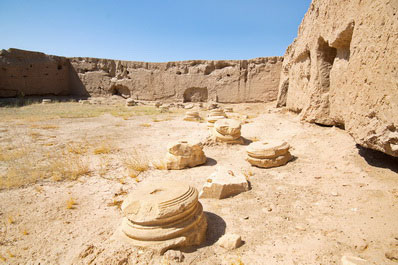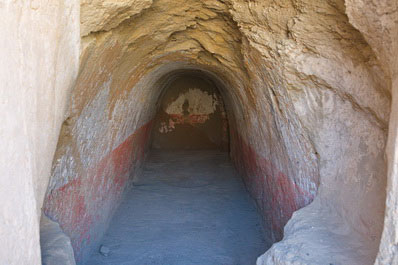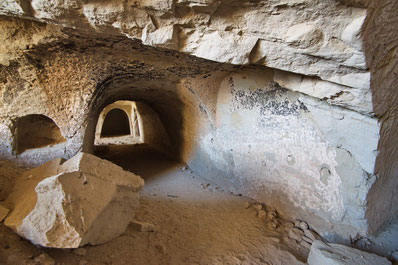Buddhist Cult Center Kara-Tepa, Termez

To the northwest of Old Termez, on the left bank of the Amu Darya river, there is a three-head hill. The local people call it Kara-Tepa, which means “Black Hill”. From its southern, the highest point one can clearly observe the citadel, surrounded by walls, and the ruins of the ancient town. The first archeological excavations took place at Kara-Tepa in 1936. They proved that centuries-old loess cultural layers hide a temple complex with cave monastery, founded by Buddhist monks at the end of the 1st century.
At Kara-Tepa archeologists discovered three tiers of rock-hewn cells for monks. The excavations revealed clearly visible layout of the ancient structures. Two-millennium-old stone steps lead down under the earthen vault whose diameter is 5 metres. In the underground chambers archeologists found fragments of statues of Buddha and Bodhisattvas, statuettes of dragons and of a winged lion, as well as wall paintings with one of the world’s oldest images of Buddha surrounded by monks. On the same walls there are portraits of donators, who were rich enough to order the construction of the temple. In the cells there were found ceramic lamps, reliquary boxes, coins of the times of Kanishka I and the Sassanid rulers. Kara-Tepa complex also had a vihara (‘dwelling’ in Sanskrit) – a dormitory, where pilgrims could take shelter. The walls of this dormitory bear the surviving graffiti picture of a Buddhist stupa.
On the plastered walls, in the niches for sculptures, and on the ceramic containers there are Bactrian, Indian, Persian and more recent Arabic inscriptions. Of a particular value are ceramic containers with Indian Buddhist inscriptions in Brahmi and Kharoshti scripts. In the monastery there were also above-ground structures built of square adobe bricks. Inner yards were paved with brick slabs and flanked on either side with aivans supported by wooden pillars. The splendid stone pedestals of the pillars still survive. In the complex there are also remains of two stupas – symbolic Buddhist reliquary structures.
The cult complex of Kara-Tepa is one of the world’s oldest surviving Buddhist cave monasteries. The Chinese monk Xuan Zang, who made a pilgrimage to India early in the 7th century in search of holy Buddhist books, mentioned his visit to shrines of Kara-Tepa in his famous travelogue “Records of the Western World”. Over the last ten years Uzbek and Japanese experts have done joint archeological research at Kara-Tepa.





